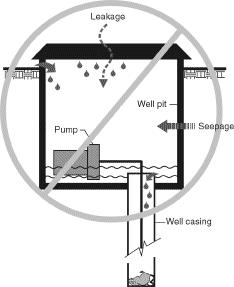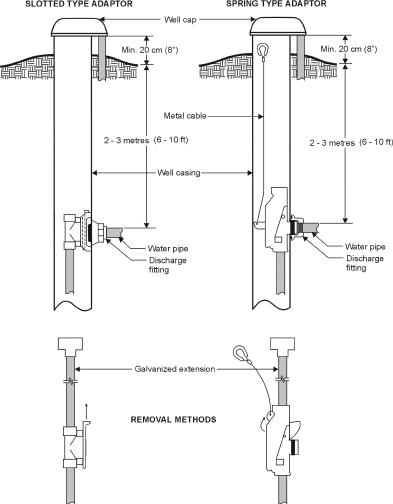| | Installation | Removal
Pitless adaptors are mechanical devices used to provide frost free, sanitary well connections. They are designed to replace pump houses, which are expensive, and well pits, which are no longer legal in Alberta. Well pits can contaminate wells by allowing water from high water tables, surface flooding, or broken water lines to enter a well. Well pits can also be death traps for animals and people. Well pits can trap explosive gasses, such as methane, and explode, or asphyxiants, such as nitrogen or carbon dioxide and. (see Figure 1).

Figure 1. Well pit.
Pitless adaptors are commonly used for submersible pumps, where the pressure tank is located in a basement, pump house or shop. They can also be used for shallow and deep well jet pumps and working-head pumps. Two common pitless adaptors are the spring-type and slotted-type (see Figure 2).

Figure 2. Pitless adaptor types.
Installation
Pitless adaptors are installed 2 to 3 m (6 - 10 ft) below ground level for protection from frost. The ground is excavated around the well casing to this depth, and a hole is made in the well casing. The discharge fitting is installed and attached to the water pipe. The discharge fitting is either clamped, bolted or welded onto the casing.
Some pitless adaptors come as a 2 to 3 m (6 - 10 ft) pre-assembled unit. These adaptors are attached to the well casing that has been cut off below frost level.
Once the discharge fitting is installed and the water pipe to the pressure tnak is in place, the excavation is backfilled with clay material, then compacted. The well casing should extend a minimum of 20 cm (8 in) above the ground surface. A ventilated cap is installed for sanitary protection. The ground surface around the well should be mounded and sloped to drain water away from it.
Removal
Pitless adaptors provide convenient access to the submersible pump for maintenance or repair. Removal of the submersible pump depends on the type of pitless adaptor installed. However, to avoid injury when pulling up the pump, be sure to review the manufacturer’s instructions for the specific type of pitless adaptor.
Generally, a metal cable on spring-type adaptors can be pulled to disengage the spring locking mechanism, and the pump can be pulled out using the galvanized extension pipe. To avoid injury, the extension pipe must be fully supported before disengaging the pitless adaptor. Slotted-type adaptors can be pulled directly using the galvanized extension pipe, while some models require loosening of the adaptor assembly with a screwdriver or wrench before pulling out the pump.
For further information, contact any of the Agricultural Water Specialists with Alberta Agriculture and Rural Development by calling, toll free, 310-FARM (3276).
Source: Agdex FS716(C29). Revised September 2012. |
|